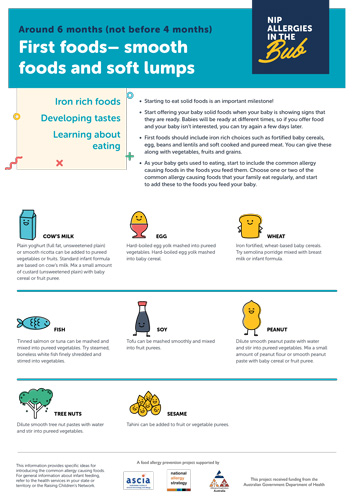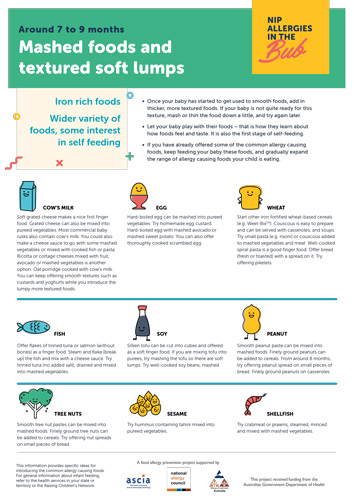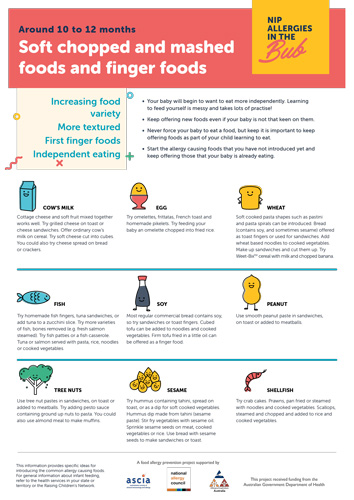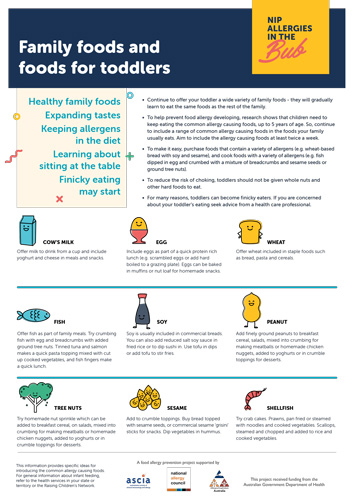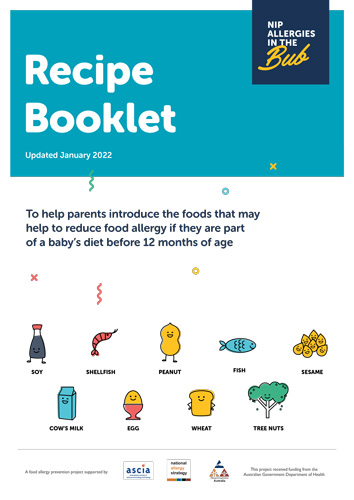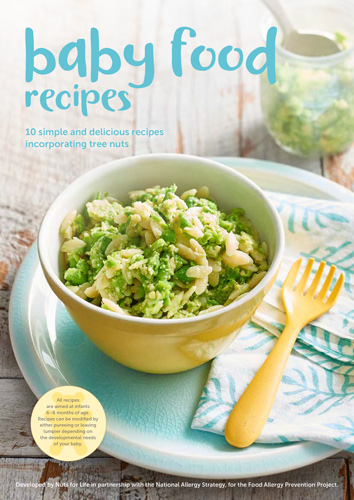Feed your baby the common allergy causing foods such as peanut, egg, tree nuts, and cow’s milk before your baby is one year of age.
Here are some ideas to help you introduce common allergy causing foods to your baby.
If your baby has had what could be an allergic reaction or is allergic to a particular food, DO NOT feed your baby that food and see your doctor for further advice.
First Foods – Around 6 months, but not before 4 months
The first foods you give to your baby need to be smooth, such as pureed food. The food should be sloppy and smooth with no lumps.
The amount the baby eats will vary each day from 1 teaspoon up to 3—4 tablespoons at mealtime. To start with, offer your baby solid foods once a day. Over time you can offer solid foods 2—3 times a day. Let your baby decide how much to eat.
You can mix a small amount of the common allergy causing food with fruit or vegetable puree or iron-fortified baby cereal. Here are some food ideas:
Egg
Hard-boiled egg mashed into pureed vegetables.
Hard-boiled egg mashed into baby cereal.
Peanut
Dilute smooth peanut paste with water and stir into pureed vegetables.
Mix a small amount of peanut flour or smooth peanut paste with baby cereal or fruit puree.
Children under 5 years of age should only be given peanuts as a smooth nut butter or paste or as nuts ground up to be a powder or flour.
Cow’s Milk
Plain yoghurt (full fat, unsweetened plain) or smooth ricotta can be added to pureed vegetables or fruits.
Standard infant formula are based on cow’s milk.
Mix a small amount of custard (unsweetened plain) with baby cereal or fruit puree.
Wheat
Iron fortified, wheat-based baby cereals.
Try semolina porridge mixed with breast milk or infant formula.
Soy
Tofu can be mashed smoothly and mixed into fruit purees.
Fish
Tinned salmon or tuna can be mashed and mixed into pureed vegetables.
Try steamed, boneless white fish finely shredded and stirred into vegetables.
Tree Nuts
Dilute smooth tree nut pastes with water and stir into pureed vegetables.
Children under 5 years of age should only be given tree nuts as a smooth nut butter or paste or as nuts ground up to be a powder or flour.
Sesame
Tahini can be added to fruit or vegetable purees.
Around 7–9 months
Once your baby is eating smooth textured foods well, you can start to give them foods that are more lumpy in texture.
Try mashed, grated, minced and finely chopped foods. You can also try soft finger-foods that your baby can hold and chew. Here are some food ideas:
Egg
Hard-boiled egg can be mashed into pureed vegetables.
Try homemade egg custard.
Hard-boiled egg with mashed avocado or mashed sweet potato.
You can also offer thoroughly cooked scrambled egg.
Peanut
Smooth peanut paste can be mixed into mashed foods.
Finely ground peanuts can be added to cereals.
From around 8 months, try offering peanut spread on small pieces of bread.
Finely ground peanuts on casseroles.
Children under 5 years of age should only be given peanuts as a smooth nut butter or paste or as nuts ground up to be a powder or flour.
Tree Nuts
Smooth tree nut pastes can be mixed into mashed foods.
Finely ground tree nuts can be added to cereals.
Try offering nut spreads on small pieces of bread.
Children under 5 years of age should only be given tree nuts as a smooth nut butter or paste or as nuts ground up to be a powder or flour.
Cow’s Milk
Soft grated cheese makes a nice first finger food.
Grated cheese can also be mixed into pureed vegetables.
Most commercial baby rusks also contain cow’s milk.
You could also make a cheese sauce to go with some mashed vegetables or mixed with cooked fish or pasta.
Ricotta or cottage cheeses mixed with fruit, avocado or mashed vegetables is another option.
Oat porridge cooked with cow’s milk.
You can keep offering smooth textures such as custards and yoghurts while you introduce the lumpy more textured foods.
Wheat
Start other iron fortified wheat-based cereals (e.g. Weet-BixTM).
Couscous is easy to prepare and can be served with casseroles, and soups.
Try small pasta (e.g. risoni) or couscous added to mashed vegetables and meat.
Well-cooked spiral pasta is a good finger food.
Offer bread (fresh or toasted) with a spread on it.
Try offering pikelets.
Soy
Silken tofu can be cut into cubes and offered as a soft finger food.
If you are mixing tofu into purees, try mashing the tofu so there are soft lumps.
Try well-cooked soy beans, mashed.
Fish
Offer flakes of tinned tuna or salmon (without bones) as a finger food.
Steam and flake (break up) the fish and mix with a cheese sauce.
Try tinned tuna (no added salt), drained and mixed into mashed vegetables.
Shellfish
Try crabmeat or prawns, steamed, minced and mixed with mashed vegetables.
Sesame
Try hummus containing tahini mixed into pureed vegetables.
Around 10 — 12 months
Once your baby is eating lumpy foods well, you can start to give them foods that have more texture.
Try soft chopped foods and finger foods. Here are some food ideas:
Egg
Try omelettes, frittatas, French toast and homemade pikelets.
Try feeding your baby an omelette chopped into fried rice.
Peanut
Use smooth peanut paste in sandwiches, on toast or added to meatballs.
Children under 5 years of age should only be given peanuts as a smooth nut butter or paste or as nuts ground up to be a powder or flour.
Tree Nuts
Use tree nut pastes in sandwiches, on toast or added to meatballs.
Try adding pesto sauce containing ground up nuts to pasta.
You could also use almond meal to make muffins.
Children under 5 years of age should only be given tree nuts as a smooth nut butter or paste or as nuts ground up to be a powder or flour.
Cow’s Milk
Cottage cheese and soft fruit mixed together works well.
Try grilled cheese on toast or cheese sandwiches.
Offer ordinary cow’s milk on cereal.
Try soft cheese cut into cubes.
You could also try cheese spread on bread or crackers.
Wheat
Soft cooked pasta shapes such as pastini and pasta spirals can be introduced.
Bread (contains soy, and sometimes sesame) offered as toast fingers or used for sandwiches.
Add wheat based noodles to cooked vegetables.
Make up sandwiches and cut them up.
Try Weet-BixTM cereal with milk and chopped banana.
Fish
Try homemade fish fingers, tuna sandwiches, or add tuna to a zucchini slice.
Try more varieties of fish, bones removed (e.g. fresh salmon steamed).
Try fish patties or a fish casserole.
Tuna or salmon served with pasta, rice, noodles or cooked vegetables.
Shellfish
Try crab cakes.
Prawns, pan fried or steamed with noodles and cooked vegetables.
Scallops, steamed and chopped and added to rice and cooked vegetables
Sesame
Try hummus containing tahini, spread on toast, or as a dip for soft cooked vegetables.
Hummus dip made from tahini (sesame paste).
Stir fry vegetables with sesame oil.
Sprinkle sesame seeds on meat, cooked vegetables or rice.
Use bread with sesame seeds to make sandwiches or toast.
Soy
Most regular commercial bread contains soy, so try sandwiches or toast fingers.
Cubed tofu can be added to noodles and cooked vegetables.
Firm tofu fried in a little oil can be offered as a finger food.
+ 12 Months Family Foods and Foods for Toddlers
Once your baby is eating textured and soft finger foods, you can introduce healthy family foods and start expanding their tastes. Here are some food ideas:
Cow’s Milk
Offer milk to drink from a cup and include yoghurt and cheese in meals and snacks.
Egg
Include eggs as part of a quick protein rich lunch (e.g. scrambled eggs or add hard boiled to a grazing plate).
Eggs can be baked in muffins or nut loaf for homemade snacks.
Wheat
Offer wheat included in staple foods such as bread, pasta and cereals.
Fish
Offer fish as part of family meals.
Try crumbing fish with egg and breadcrumbs with added ground tree nuts.
Tinned tuna and salmon makes a quick pasta topping mixed with cut up cooked vegetables, and fish fingers make a quick lunch.
Soy
Soy is usually included in commercial breads.
You can also add reduced salt soy sauce in fried rice or to dip sushi in.
Use tofu in dips or add tofu to stir fries.
Peanut
Add finely ground peanuts to breakfast cereal, salads, mixed into crumbing for making meatballs or homemade chicken nuggets, added to yoghurts or in crumble toppings for desserts.
Children under 5 years of age should only be given peanuts as a smooth nut butter or paste or as nuts ground up to be a powder or flour.
Tree Nuts
Try homemade nut sprinkle which can be added to breakfast cereal, on salads, mixed into crumbing for making meatballs or homemade chicken nuggets, added to yoghurts or in crumble toppings for desserts.
Children under 5 years of age should only be given tree nuts as a smooth nut butter or paste or as nuts ground up to be a powder or flour.
Sesame
Add to crumble toppings.
Buy bread topped with sesame seeds, or commercial sesame ‘grisini’ sticks for snacks.
Dip vegetables in hummus.
Shellfish
Try crab cakes.
Prawns, pan fried or steamed with noodles and cooked vegetables.
Scallops, steamed and chopped and added to rice and cooked vegetables.

This information provides specific ideas for introducing the common allergy causing foods. For general information about infant feeding, refer to the health services in your state or territory or the Raising Children’s Network.

It is important to keep feeding your baby the allergy causing foods once you have introduced them
Once you have fed your baby the common allergy causing foods, it is important to continue to include these foods in your baby’s meals at least twice a week. This is important because if you feed your baby the common allergy causing foods but your baby does not continue to eat these foods regularly, they could develop a food allergy if they haven’t eaten the food for some time.
There is no clear research to tell us exactly how much of the allergy causing foods your baby needs to eat to prevent food allergy, so it is recommended that you choose small amounts (e.g. 1 teaspoon) to start with and increase the amount as your baby grows and eats more. For example, once you have fed your baby egg for the first time, you should include well cooked (never raw or runny) egg in your baby’s food at least twice a week.
- For a younger baby around 6 months of age, this may mean including well cooked egg in a food (such as pureed vegetables) that they normally eat.
- For older babies on more textured food (around 7-9 months), you might feed your baby scrambled egg or mash a hard boiled egg together with mashed potato.
- Once your baby is eating finger foods (around 12-18 months), you can include egg in many foods such as muffins, pikelets or a chopped up omelette in fried rice.
The important thing is to include the food at least twice a week. If your baby has had what could be an allergic reaction or is allergic to a particular food, do not feed your baby that food.
Recipes for your baby
Looking for ideas of how to introduce the common allergy causing foods into your baby’s diet? Download our free food ideas and recipe booklets.

